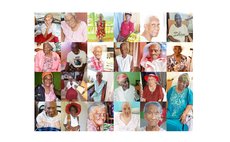HIV/AIDS: Major compromises needed to "Get to Zero"
Occupied by the aftermath of Tropical Storm Erika, Dominicans almost forgot the annual observance of World Aids Day (WAD) on 1st December 2015.
Having been preoccupied over the past five years with news of Ebola and Chikungunya, HIV/AIDS have been thrown out of the headlines.
Nonetheless, the disease continues to be an extremely serious health and social problem especially in the Caribbean.
Medical authorities have reported that in 2013 an estimated 12,000 persons in the Caribbean became infected with HIV but fewer patients have died of AIDS than in the past, thanks to the implementation of anti-retroviral therapy. In 2013, as well, 250, 000 adults and children are living with the virus. Although these figures show a 40 percent decline in new infections since 2001, and 54% percent decline in deaths since 2005, the Caribbean still remains, after sub-Saharan Africa, a region of higher HIV prevalence than any other region in the world, with 1.1 percent of the adult population infected.
The region as a whole has been able to achieve 67 percent access to antiretroviral drugs (ARVs) in the general population, and 79 percent access for pregnant women to prevent mother-to-child transmission (MTCT) of HIV. These achievements rival the achievements made in some high-income countries.
In Dominica in 2014, HIV/AIDS prevalence is about 0.75 percent of the population and health workers report that they see about 12-15 new cases of HIV and AIDS every year. From 1987, Dominica has recorded 4010 cases of HIV/ AIDS and many have died.
Reflecting global patterns, heterosexual sex is the main route of HIV transmission throughout the region and largely associated with commercial paid sex. Women are particularly vulnerable to HIV infection; but more than 75 percent of people living with HIV in Dominica are men. And interesting statistic is that a significant number of older men are contracting the disease.
The spread of HIV in the Caribbean has taken place against a common background of poverty, gender inequalities and a high degree of HIV-related stigma. Migration between islands and countries is common, contributing to the spread of HIV and blurring the boundaries between different national epidemics, Avert.org stated.
And most alarmingly, AIDS continues to be one of the leading causes of death in the region along with diseases such as diabetes and hypertension. We also note that the predominant route of transmission of the disease in the Caribbean is through heterosexual contact mainly through the commercial sex trade. All this, unfortunately, is contributing to this providing the region with the unflattering record of being the second highest infected region in the world, behind sub-Saharan Africa. But there has been progress especially in the provision of antiretroviral drugs to affected persons.
Nevertheless, AIDS experts in the Caribbean tell us that there will not be sustainable progress in the fight against the disease unless we seriously tackle the problem of discrimination and perceived stigma associated with the disease.
Additionally, the pressure to end discrimination against persons because of their sexual preferences has been heightened by some of the Caribbean's leading medical researchers. Some time ago, Peter Figueroa, a professor of public health at the University of the West Indies said the Caribbean cannot continue such discrimination while we remain one of areas in the world where AIDS is most rampant.
Thus the issue of the decriminalization of homosexuality, which could lead to the reduction in the levels of homophobia in the Caribbean, is one of the most contentious issues that the region has had to confront.
This is important because although the joint United Nations programme on HIV\AIDS (UNAIDS) reports that prevention programmes worldwide are yielding better results, the global AIDS pandemic continues to be a major concern.
According to Anthony S. Fauci of the National Institute of Allergy and Infections, in 2012, more than two million new HIV infections and 1.6 million AIDS-related deaths occurred globally. He said that although these numbers represent a decline from previous years, they also reflect a grim reality: far too many people become HIV-infected and die from the effects of the disease.
Although that form of prejudice is directed at all persons who have AIDS, no matter how they contracted the disease, homosexuals with and without AIDS feel the greatest pressure from society because of their life style. Homophobia, defined as an extreme and irrational aversion to homosexuality and homosexuals, is rampant in the Caribbean especially in countries like Jamaica with a predominant Rastafarian community. This level of discrimination makes little sense since the dominant form of transmission of AIDS in the Caribbean is heterosexual and not homosexual.
Nevertheless, in the context of fighting the spread of AIDS there have been suggestions that unless the Caribbean community takes measures to reduce homophobia, gay men who are affected by the virus will remain in the closet and continue pretending that they are heterosexual to avoid the pain of being outcasts of society.
What this does is to cause carriers of the disease to remain underground and thus fuel the spread of AIDS. Of course, it goes without saying that the church will be the major obstacle to any move to legalise homosexuality in the Caribbean even though the church understands the rationale.
In fact, the Catholic Church, in particular, has been severely criticized for it so-called intransigence on the issue of the use of condoms as a means of reducing the spread of the disease, even if most Catholics ignore the church's teachings on the subject. But on the issue of the legalization of homosexuality the church will continue to argue that to accept these sexual preferences as a means of reducing the spread of AIDS is to condone promiscuity and to disregard the basic teachings of the Church on homosexuality. Most medical professionals disagree.
Nevertheless, health officials who are at the forefront of the war against HIV\AIDS need to find ways to engage the Church in the battle irrespective of its stance on the issue of condom use and homosexuality. National policy makers and the Church must realise that AIDS is much more than a problem related to health, culture or economics. AIDS is about life and death. "Getting to Zero", as the HIV/AIDS slogan for 2015 suggests, requires major compromises from church and State.




